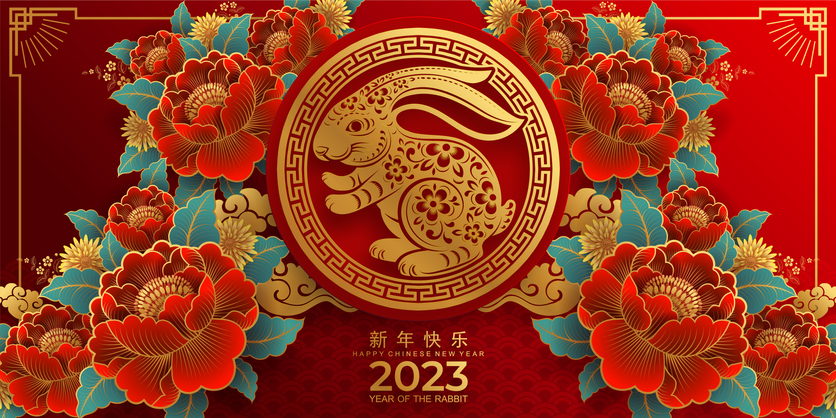Celebrating Lunar New Year in 2023

Happy New Year!
No, this isn’t three weeks late. Based on the lunar-solar calendar, the Chinese New Year 2023 celebration began on January 22, the day of the second new moon following the winter solstice. It will conclude with the Lantern Festival on February 5, timed with the full moon. Each New Year is always associated with one of 12 earthly animals and one of five elements—for example, 2022 was the Year of the Tiger with Water element.
What does this year’s animal symbolize?
2023 marks the Year of the Rabbit (Water). The Rabbit symbolizes kindness and peace, so 2023 is predicted to be a year of hope. In the Chinese zodiac where each animal rotates every 12th year, Rabbits have been born in 2011, 1999, 1987, 1975, 1963, 1951, and so on. They are said to be great scholars, empathetic, artistic and kind. Just like its real-life counterpart, the Rabbit personality in Chinese culture is quiet, sensitive, and careful, but with great inner strength and confidence. People born in Rabbit years are said to be great scholars, empathetic, artistic, and kind.
For older adults identifying with Asian cultures and backgrounds, the Lunar New Year rituals, traditions, and symbolism can hold powerful meaning and memories. And seniors might identify with the Rabbit in particular; they may highly value kindness, learning, and artistic creativity. But through their life experience, seniors have developed inner strength, wisdom, and resilience—all pillar characteristics of a healthy society. The Year of the Rabbit can be both a reminder of and a time to reflect on sharing all these characteristics with others.
How do different cultures celebrate this New Year?
The celebration known as the Chinese New Year is named so because its origins are thought to trace back to 14th century B.C. China. According to legend, bright lights, loud noises, and the color red were used to frighten and drive away a village monster who appeared at the start of every year.
But other Asian cultures and communities stemming from countries including Korea, Mongolia, Tibet, Singapore, Thailand, Philippines, and Vietnam may celebrate this as the Lunar New Year or Spring Festival. (This may seem oddly named this far ahead of the spring solstice, but it’s to prepare for and usher in the season of new life and new beginnings.)
By any name, this New Year represents reunion and rebirth, hope for luck and prosperity, and the transition from winter to spring. Whether long or short, the holiday is a time to gather with family and honor ancestors and deities. It’s filled with family reunions, bright colors, fireworks, parades, dances, rituals, and, of course, all kinds of delicious foods. But the traditions, celebrations, and even timelines are as diverse as the Asian cultures that celebrate.
(You might be surprised to learn that even the animal isn’t universal throughout all Asian cultures. This year, while most Asian cultures will mark the year of the Rabbit, the Vietnamese will be celebrating the Year of the Cat.)
There is one ritual most have in common, though: cleaning! Before the New Year comes in, most cultures deep-clean their homes to get rid of old or negative energy and bad luck.
In China, millions travel all over to spend the New Year with families and honor ancestors. Family members may give and exchange red envelopes containing money, symbolizing good wishes and luck in the new year. Dances, fireworks, and firecrackers are prevalent throughout the holidays, but with the biggest celebrations on New Year’s Eve and New Year’s Day. Since the dragon is a Chinese symbol of power and good fortune, many areas of the country have dragon dancing, during which a long, colorful dragon puppet is paraded through the streets, as the highlight of festivities.
In Mongolia, the New Year festival is called Tsagaan sar; some call it The White Moon festival. People worship at ovoo, which are stone heaps used as altars or shrines. They also exchange snuff bottles, which are thought to unite people. (The Tibetan and Mongolian cultures are expected to celebrate their Lunar New Year later in the winter, on February 20.)
In Vietnam, the day is called Tết Nguyên Đán, or Tết, which translates to Festival of the First Morning of the First Day. Many people clean their houses and decorate them with fresh flowers, such as peach blossoms and kumquats. The pink of the peach blossom represents energy and the kumquat represents prosperity.
In North Korea and South Korea they celebrate Seollal, which lasts for three days. Korean families may serve food to ancestors, in a ritual called Charye, to gain their blessings for the coming year. Families exchange gifts and cook rice cake soup and savory pancakes. A little surprisingly, South Koreans consider tins of Spam a favorite New Year gift, both to give and to receive!
A holiday for celebrating family.
At the heart of all the parades, feasts, and gifts, the focal point of the New Year remains the gathering and honoring of ancestors, family, and households. The extravagant celebrations marking this holiday serve as a reminder of the culturally rich traditions that have evolved over generations. It’s a time set aside to reflect on ancestors and thank them for their hard work and heritage, as well as to love and connect with the family still with us.
Whatever your cultural traditions, we hope that you can enjoy the celebrations and positivity that the Lunar New Year brings, and find gratitude for your history and the good fortune within your own life.
Related Posts

Podcast: A Day in the Life at Era Living – Resident Diane Miller

Podcast: Advocating for Retirees in Senior Living

